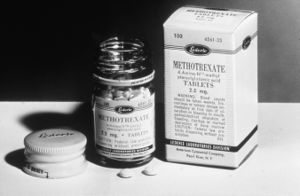DMARDs in the Management of Rheumatoid Arthritis
Introduction[edit | edit source]
Disease-modifying antirheumatic drugs (DMARDs) are a class of drugs indicated for the treatment of rheumatoid arthritis (RA), which is a symmetric, inflammatory, polyarthritis of unknown etiology. DMARDs are crucial in preventing joint deformities and injuries that can occur as a result of rheumatoid arthritis (RA). [Image shows one of the first chemotherapeutic drugs used in the early 1950's Methotrexate]
These drugs are immunosuppressives designed to slow the damage done to joints, and they can induce or maintain remission, reduce the frequency of flare-ups, and allow for tapering of steroids while sustaining disease control.They can also be used to in the treatment of other autoimmune disorders eg scleroderma, spondyloarthritis, inflammatory myositis, inflammatory bowel disease, systemic lupus erythematosus.[1]
In essence, they interfere with the cellular signaling cascade that promotes inflammation[2]. A patient diagnosed with RA will achieve the best possible prognosis by starting DMARD therapy as soon as the diagnosis is made[3]. Traditional DMARDs include methotrexate, leflunomide, hydroxychloroquine, and sulfasalazine. Others include cyclophosphamide, cyclosporine, and tacrolimus (FK506), but these are of limited use.[1] Hydroxychloroquine (HCQ) and Methotrexate (MTX) are the most commonly used drugs[4]. This 3 minutes video gives a good overview
Pharmacokinetics[edit | edit source]
DMARDs can be administered orally or intravenously[2]. They can be administered alone or in conjunction with other drugs[6].
HCQ is most often the DMARD of choice in the initial stages of treatment. In the body, HCQ increases the pH in cells, which alters protein degradation and thus results in down-regulation of the immune system. Typical doses for adult patients range from 300 mg/day to 400 mg/day. HCQ is then partially metabolized by the liver[6].
MTX is an immunomodulatory compound. It interferes with DNA synthesis by reducing neutrophil adhesion and pyrimidine supply in dividing cells. In addition, MTX inhibits gene expression and cell-mediated immunity in the body[2]. The dosing ranges from 7.5 mg/week to 25 mg/week as the patient progresses through the treatment regimen. It is then metabolized and excreted by the kidneys[6].
Monitoring[edit | edit source]
- Most DMARDs which cause myelosuppression and hepatotoxicity can be monitored with a complete blood count (CBC) and liver function tests every 2 weeks to monthly.
- Those that cause macular damage (hydroxychloroquine) should be monitored with funduscopic exams twice yearly.[1]
Clinical Implications[edit | edit source]
All patients prescribed DMARDs need to be closely followed to monitor their effectiveness and side effects. If the patient presents with any life-threatening adverse effects, the patient should cease taking the medication and seek medical help[2].
DMARDs are very powerful drugs which modulate sequences in the immune system. Their adverse effects can range from mild (rash, nausea, vomiting, stomatitis) to severe, life-threatening infections; therefore, frequent monitoring is required. As a group, conventional DMARDs can cause[1]
- gastrointestinal (GI) distress,
- bone marrow suppression,
- neutropenia,
- interstitial lung disease
- hepatotoxicity
- skin irritation
- headache
- neuropathy
- increased risk of cardiovascular issues (bDMARDs should be used instead for patients with a preexisting cardiovascular condition[7])
Methotrexate has been known to cause neurotoxicity, pneumonitis and liver disease including cirrhosis. Of note, a recent study suggests methotrexate (in combination with bisphosphonates) is a risk-factor for bisphosphonate-induced osteonecrosis of the jaw. In another case, hydroxychloroquine (HCQ) can cause retinopathy (macular damage) and rash. Leflunomide can cause diarrhea, alopecia, and elevated liver transaminases.
The PT should be aware of the above issues when treating a patient receiving DMARDs as these symptoms can negatively affect the treatment session
References[edit | edit source]
- ↑ 1.0 1.1 1.2 1.3 Benjamin O, Lappin SL. Disease modifying anti-rheumatic drugs (DMARD). InStatPearls [Internet] 2019 Jan 6. StatPearls Publishing. Available from: https://www.ncbi.nlm.nih.gov/books/NBK507863/ (last accessed 30.12.2019)
- ↑ 2.0 2.1 2.2 2.3 Benjamin O. Disease Modifying Anti-Rheumatic Drugs (DMARD). Current neurology and neuroscience reports. https://www.ncbi.nlm.nih.gov/books/NBK507863/. Published October 27, 2018.
- ↑ Smolen JS, Landewé R, Breedveld FC, et al. EULAR recommendations for the management of rheumatoid arthritis with synthetic and biological disease-modifying antirheumatic drugs: 2013 update. Annals of the Rheumatic Diseases. https://ard.bmj.com/content/73/3/492. Published March 1, 2014.
- ↑ Singh JA, Furst DE, Bharat A, et al. 2012 update of the 2008 American College of Rheumatology recommendations for the use of disease-modifying antirheumatic drugs and biologic agents in the treatment of rheumatoid arthritis. Current neurology and neuroscience reports. https://www.ncbi.nlm.nih.gov/pubmed/22473917. Published May 2012
- ↑ Marina Spyridis Design & Illustration DMARDs Available from: https://www.youtube.com/watch?v=nR5EpuMxQSc&feature=youtu.be (last accessed 30.12.2019)
- ↑ 6.0 6.1 6.2 Kumar P, Banik S. Pharmacotherapy Options in Rheumatoid Arthritis. https://www.ncbi.nlm.nih.gov/pmc/articles/PMC3747998/. Published August 8, 2013.
- ↑ Solomon DH, Curtis JR, Saag KG, et al. Cardiovascular risk in rheumatoid arthritis: comparing TNF-α blockade with nonbiologic DMARDs. Current neurology and neuroscience reports. https://www.ncbi.nlm.nih.gov/pubmed/23885678. Published August 2013.







